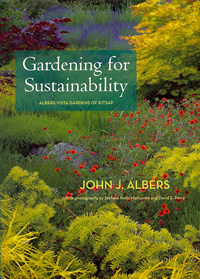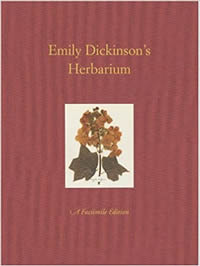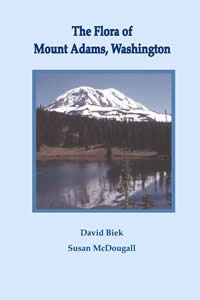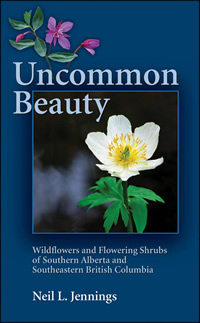
Jim Fox is a consumer advocate. More specifically, a gardening consumer advocate. His goal is “…to educate you to be a savvy consumer so you can be confident that your gardening dollars are well spent.” To achieve this goal, he has written a shopping guide: “How to Buy the Right Plants, Tools & Garden Supplies.”
Many general gardening books touch on plant buying or tool selection, but typically at the back of the book, or in a brief introduction that the reader hastily skims over to get the real excitement–an encyclopedia of plants in glorious color. Fox recognizes how critical this basic information is for all gardeners, experienced or not, and uses clarity, broad experience, and considerable wit to engage the reader, leaving the colorful photos and plant bios to the several other books that he recommends.
I found the author’s insights into the process of buying and selling plants particularly engaging, demonstrating his perspectives as both an avid collector of specialty plants, and as a long-time nursery worker. “To get good service, you need to be a good customer,” he strongly recommends. For example, spouting your own expertise is a quick way to shut down any helpful advice you might have received from the true expert.
After reading this book, I have a much better appreciation for the dedicated men and women who own and run nurseries and must be skilled at managing both plants and people. All so that we can have the cool plants we really, really want.
Excerpted from the Fall 2013 Arboretum Bulletin.

“Gardening for Sustainability” is almost two books in one. The first part takes you on an intimate tour of the Albers Vista Gardens near Bremerton, approximately four acres lovingly crafted by author John Albers and his wife Santica Marcovina over the last 15 years. I kept a post-it note on the garden map for frequent reference as I walked page-by-page through the 14 garden rooms; the history, purpose, and plantings of each made very real by the considerable descriptive detail and excellent photographs.
“As visitors stand among the Three Islands dreaming of distant lands, they have the choice of proceeding through the open sea of crushed granite or continuing up Madrona Lane.” Transitions like this hold your interest as you continue your tour, while picking up ideas to use for your own garden such as, “…the underutilized Chaste tree [Vitex agnus-castus]…is an ideal substitute for the [invasive] butterfly bush [Buddleia davidii].”
The author’s enthusiasm is especially apparent in a chapter on special collections, including dwarf conifers, striped-bark and Japanese maples, and viburnums. Much of his interest in the latter genus was sparked by the collection at the Washington Park Arboretum, which he studied and described while taking classes through the Center for Urban Horticulture in the 1990s.
The second part of the book is a concise essay on landscape sustainability–excellent reading for any gardener. These principles and practices are the basis for the design and maintenance of the Albers Vista Garden, but despite best intentions the author freely admits that errors do happen. He concludes that it is best to “…learn from your mistake and move on to the next joyful garden project.”
The garden is open to visitors by appointment or for special events. More information is available at www.albersvistagardens.org.
Excerpted from the Fall 2013 Arboretum Bulletin.

“Quiet Beauty: The Japanese Gardens of North America” is itself a book of quiet beauty, and an excellent introduction to Japanese-style gardens throughout Canada and the United States. Photographer David Cobb, from Mosier (near Hood River), Oregon, is particularly adept at emphasizing the contrasts between light and shadow, the subtle reflections in still waters, and the energy of moving water in his subjects. I have visited many of the 26 featured gardens and he captures the spirit of these very well.
Text author Kendall Brown is an Asian Art historian at California State University, Long Beach. His introductory essay places these gardens in the context of what he sees as five distinctive, historical periods beginning at the end of the 19th century. The Seattle Japanese Garden, along with gardens in Portland, at the University of British Columbia, and at the Bloedel Reserve on Bainbridge Island, are all placed in the second of these periods, a time of “Building Bridges” following World War II.
Feeling regional pride, I read the chapter on this period first, and I wasn’t disappointed. Brown is good at telling (what are often) convoluted histories. He underscores the importance of our local gardens in the development of the Japanese style in North America: “The Seattle Japanese Garden also set a new standard as the earliest major permanent garden built in North America by well-established designers from Japan.” He further compliments it as being “…arguably one of the finest in North America.”
Featured in a later chapter is Spokane’s Nishinomiya Garden in Manito Park, while another ten gardens from throughout Washington (including the Kubota Garden) and British Columbia are briefly described in the appendices, making this an important garden book for the Pacific Northwest. Brown’s earlier (1999) book, “Japanese-Style Gardens of the Pacific West Coast”, is also worth reading for a more in-depth general history of this style.
Excerpted from the Fall 2013 Arboretum Bulletin.
 An important contributor to our Pacific Northwest literature has been Steve Solomon, now with his 6th edition of “Growing Vegetables West of the Cascades.” Each edition reflects the author’s on-going learning in his craft, the major change in this edition concerns the cultivation of asparagus. He now advocates growing these from seed, rather than starting with root crowns.
An important contributor to our Pacific Northwest literature has been Steve Solomon, now with his 6th edition of “Growing Vegetables West of the Cascades.” Each edition reflects the author’s on-going learning in his craft, the major change in this edition concerns the cultivation of asparagus. He now advocates growing these from seed, rather than starting with root crowns.
![[Wild Plants of Greater Seattle] cover](https://depts.washington.edu/hortlib/graphix/WildPlantsGreaterSeattle.jpg)
Arthur Lee Jacobson’s “Wild Plants of Greater Seattle” was received with great excitement when published by the author in 2001. In the second edition, the author has added 15 new plants to the illustrated field guide, plus more than 100 to the annotated checklist, and corrected or updated much of the nomenclature throughout.
 “Emily Dickinson’s Herbarium” is a full-size, facsimile of an album of pressed flowers, leaves, and other plant parts created in the 1840s when Dickinson was a student at Amherst Academy. There is no stated purpose or obvious order to this collection, which includes both native plants of western Massachusetts and specimens that could only come from a garden or conservatory. As a traditional herbarium the value is limited, as none of the important collection information (date, exact location, etc.) are recorded.
“Emily Dickinson’s Herbarium” is a full-size, facsimile of an album of pressed flowers, leaves, and other plant parts created in the 1840s when Dickinson was a student at Amherst Academy. There is no stated purpose or obvious order to this collection, which includes both native plants of western Massachusetts and specimens that could only come from a garden or conservatory. As a traditional herbarium the value is limited, as none of the important collection information (date, exact location, etc.) are recorded.
Over 400 specimens survive, some accurately labeled by the author using botanical guides of the day, others with descriptive if incorrect Latin binomials (for example, Petunia alba for a white petunia). Others have lost their labels. The Harvard University Herbaria staff has identified nearly all despite numerous challenges. A detailed catalog records all this detective work.
But the value of this book is not as a traditional herbarium. I see it as a piece of history, and of an early glimpse of the life of one of our country’s most valued poets. And, if you’ve ever attempted your own collection of pressed plants, you will appreciate the considerable effort taken not only to produce this book, but also to preserve it for over 160 years.
Accompanying essays document the herbarium’s conservation, the history of the family battles over Dickinson’s legacy, and securing the Dickinson collection for Harvard. Best is the article by Richard B. Sewall, “Science and the Poet: Emily Dickinson’s Herbarium and ‘The Clue Divine,'” in which he begins, “Take Emily’s Herbarium far enough, and you have her.” Perhaps. In any case, he argues for the close connection she found between science and art — an argument that could be equally well applied to William Bartram.
“Emily Dickinson’s Herbarium,” because of its size, cannot be checked out, but is available to all to study and view in the Miller Library.
Excerpted from the Summer 2008 Arboretum Bulletin.
 “The Wild Within” is a photo collection highlighting the wetlands — with a special emphasis on the animals of the Washington Park Arboretum. It is a real page-turner, but pages that you’ll return to and savor frequently with an even deeper appreciation of the value of our Arboretum.
“The Wild Within” is a photo collection highlighting the wetlands — with a special emphasis on the animals of the Washington Park Arboretum. It is a real page-turner, but pages that you’ll return to and savor frequently with an even deeper appreciation of the value of our Arboretum.
Essays provide occasional breaks in the photographs and they are well worth reading. Notables Dale Chihully, Dan Evans, Peter Steinbrueck, William Ruckelshaus and others shed their public faces to give very personal accounts of the importance of the Arboretum.
Excerpted from the Fall 2008 Arboretum Bulletin.
 “The Last Oasis,” by Seattle Times photographer Tom Reese extends a bit beyond the Arboretum in its scope, including human subjects and their impact, some of it benign but much that’s troubling. However the message is much the same — these urban wetlands are a treasure that is critical to preserve.
“The Last Oasis,” by Seattle Times photographer Tom Reese extends a bit beyond the Arboretum in its scope, including human subjects and their impact, some of it benign but much that’s troubling. However the message is much the same — these urban wetlands are a treasure that is critical to preserve.
Excerpted from the Fall 2008 Arboretum Bulletin.
 For the serious student of native plants, “The Flora of Mount Adams, Washington” will be an important work. Considered to be the most diverse flora in the state, Mt. Adams hosts several, quite distinct habitats and over 800 distinct species of plants. As there are no photographs and only botanist-oriented descriptions and identifying keys, this is not for the casual seeker of wildflowers. Instead, look for co-author Susan McDougall’s “The Wildflowers of Mount Adams, Washington.”
For the serious student of native plants, “The Flora of Mount Adams, Washington” will be an important work. Considered to be the most diverse flora in the state, Mt. Adams hosts several, quite distinct habitats and over 800 distinct species of plants. As there are no photographs and only botanist-oriented descriptions and identifying keys, this is not for the casual seeker of wildflowers. Instead, look for co-author Susan McDougall’s “The Wildflowers of Mount Adams, Washington.”
Excerpted from the Fall 2008 Arboretum Bulletin.
 Excellent photographs are the outstanding quality of “Uncommon Beauty”, a new field guide focused on an underexplored part of the Pacific Northwest — southeastern British Columbia. Written by an enthusiastic outdoorsman and native of the area, Neil L. Jennings provides a very readable description of over 200 plants, many who have ranges that extend southward into eastern Washington.
Excellent photographs are the outstanding quality of “Uncommon Beauty”, a new field guide focused on an underexplored part of the Pacific Northwest — southeastern British Columbia. Written by an enthusiastic outdoorsman and native of the area, Neil L. Jennings provides a very readable description of over 200 plants, many who have ranges that extend southward into eastern Washington.
Excerpted from the Fall 2008 Arboretum Bulletin.



 An important contributor to our Pacific Northwest literature has been Steve Solomon, now with his 6th edition of “Growing Vegetables West of the Cascades.” Each edition reflects the author’s on-going learning in his craft, the major change in this edition concerns the cultivation of asparagus. He now advocates growing these from seed, rather than starting with root crowns.
An important contributor to our Pacific Northwest literature has been Steve Solomon, now with his 6th edition of “Growing Vegetables West of the Cascades.” Each edition reflects the author’s on-going learning in his craft, the major change in this edition concerns the cultivation of asparagus. He now advocates growing these from seed, rather than starting with root crowns.![[Wild Plants of Greater Seattle] cover](https://depts.washington.edu/hortlib/graphix/WildPlantsGreaterSeattle.jpg)



 For the serious student of native plants,
For the serious student of native plants,  Excellent photographs are the outstanding quality of
Excellent photographs are the outstanding quality of